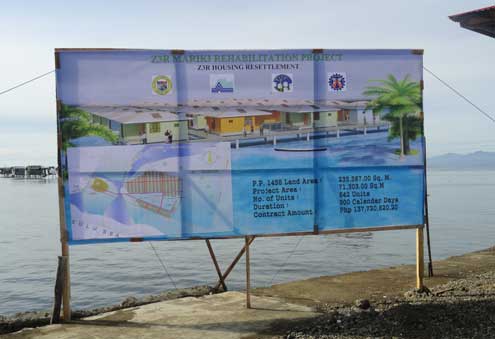InAsia
Insights and Analysis
One Year After Siege, Zamboanga Critical to Success of Any Peace Agreement
September 10, 2014
On Sept. 9, 2013, Zamboanga City woke to an unfolding nightmare. Some 200 Moro National Liberation Front (MNLF) fighters under the charismatic commander Ustadz Habier Malik had landed. They professed, despite the fact that they were fully armed, an intention merely to have a peaceful march in support of independence for Muslim-dominated areas in the southern Philippines. When government security forces halted their march, MNLF forces took hostages as a string of human shields, tying them together with rope. As a nightmare, this was a recurrence: the same tactic had been used by disaffected MNLF forces in Zamboanga City in 2001, and the resolution involved the captors marching away with their guns, shielded by hostages, and at the end releasing them unharmed (at least.)
In 2013 this was not to be. Government leaders decided not to negotiate, and the result was a drawn-out siege. Nineteen days later, 208 MNLF fighters had been killed (reportedly including Commander Malik), and 280 arrested. Twelve civilians were killed, including four of the hostages. Twenty-five members of the security forces died in the fighting. Five barangays (villages) were razed, some 10,000 houses destroyed, and some 120,000 people (mostly Muslims) displaced into makeshift shelters, the city’s grandstand, a seaside boulevard, and residences scattered throughout the city.

A view of battle-scarred Lustre Street in the center of Zamboanga City in the aftermath of fighting. Photo/Jowel Canuday
The one-year anniversary in 2014 was the occasion for considerable coverage. Al Jazeera’s Jamela Alindogan and the NGO Peace Advocates Zamboanga traced the events of the siege while other outlets such as AFP and Rappler covered the plight of those still displaced. The United Nations Office for the Coordination of Humanitarian Affairs (OCHA) reports that some 26,000 people are still in evacuation centers or transitional housing – with plans to move them all to the latter by December. Some 5,400 families are then to be accommodated in permanently built units, but that does not include some 1,661 packages of Home Materials Assistance that are meant to assist residents in self-repair. While in aggregate numbers this would cover those openly displaced, it does not include home-based displaced persons, which OCHA admits are hard to estimate and reach with services. It is clear that not all displaced residents will be allowed to return – the villages were largely informal settlements and in site preparation for residents’ return area will be devoted to streets wide enough for fire trucks, drainage to improve sanitation, access ways for bridges, walkways, and security outposts.
The city government, for its part, commemorated the anniversary on September 9 with a series of events: groundbreaking for residential “houses on stilts” in barangay Mariki for those who prefer to live on the sea; turnover of permanent housing units in barangay Sta. Catalina so that residents could return; an art exhibit produced by hundreds of children who had undergone workshops for psychosocial healing, and an ecumenical service honoring both the security forces and the hostages that included Muslim, Protestant, and Catholic speakers. Under the theme of “Build Back Better Zamboanga,” the aim of the day was to convey hope and progress in the face of unsatisfactory living conditions for displaced persons and the slow progress of return to their coastal communities.

Under the theme of “Build Back Better Zamboanga,” the aim of the anniversary event was to convey hope and progress in the face of unsatisfactory living conditions for displaced persons and the slow progress of return to their coastal communities. Above, a housing resettlement plan for displaced residents in Zamboanga. Photo/Jason Reyes
But all of this examination covers just one year, from the beginning of the siege to its commemoration. Understanding the significance of what has happened requires a longer perspective.
First, the motivation for the incursion – whether or not it was originally meant as peaceful – was MNLF dissatisfaction with the implementation of their 1996 “Final Peace Agreement” with the government, in the face of rapid progress in negotiations with the rival Moro Islamic Liberation Front (MILF). The Philippine Congress is now considering a bill that would institute a revamped “Bangsamoro” political entity to replace the Autonomous Region in Muslim Mindanao (which the MNLF ran for five or nine years depending on how you count after the 1996 agreement). In the meantime, the Organization of Islamic Cooperation still backs the MNLF as the representative of Muslims in the Philippines, and in June 2014 said that the Comprehensive Agreement on the Bangsamoro with the MILF was only a “partial implementation” of the 1996 Final Peace Agreement. In short, no progress has been made in reconciling the various elements of the MNLF to progress being made with the MILF.
Second, while considerable controversy attends the decision not to negotiate with Ustadz Malik, but rather to fight it out, the basic disposition to resist armed Muslim incursion is rooted in history. Muslims are not totally marginalized – 31 of the 98 barangays are headed by Muslims, and three members of the city council are Muslims. But the many Muslims fleeing from the Sulu archipelago over four decades of armed conflict settled in a city with a distinct character. For centuries Zamboanga was the bastion of Spanish colonial power in the southern Philippines, to the extent that the language spoken, Chavacano, is a creole language based on Spanish. And, as noted, only a dozen years before a similar hostage-taking incident had occurred as a result of MNLF dissatisfaction with how the 1996 Final Peace Agreement was being implemented. Thus, there is an allergy to being included in a peace process with Moros – just last month the city turned down a JICA-funded project in Sacol Island because it was being implemented by the development arm of the MILF, the Bangsamoro Development Agency. Sacol Island was among the areas covered under the ill-fated 2008 Memorandum of Agreement on Ancestral Domain (which was invalidated by the Supreme Court amid an upsurge of separatist violence). Zamboanga City has been adamant that no part is to be included in the Bangsamoro settlement, though it wishes Muslim-dominated areas well as they negotiate the new arrangement.
Even though it will not be part of the Bangsamoro territorial coverage, Zamboanga City is crucial to the success of any peace agreement for a number of reasons. The treatment of Muslim displaced persons needs to justify faith of the Muslim community that they are welcome in the larger Philippine nation. If a “Latin City” is seen as not caring sufficiently for its Muslim inhabitants, it strengthens the case for separatism. Economically, as an entrepôt sandwiched between the mainland hinterland of the Zamboanga Peninsula and the Muslim-dominated Sulu Archipelago, the city provides a vital link in value chains and trade routes. Culturally it is vibrant, and potentially a demonstration of the benefits of pluralism and tolerance.
Leadership, both from the city government and the various communities and peoples of Zamboanga, will be needed to fulfill potential and avoid pitfalls. The glass as of today is indeed half-empty if you look at the continuing plight of those displaced, and half-full if you look at progress that is finally being made at repairing lives. Much rides on how fast the water level rises.
Steven Rood is The Asia Foundation’s country representative in the Philippines. From 2009-2013 he observed negotiations between the government and the Moro Islamic Liberation Front as the Foundation’s representative on the International Contact Group. Since 2013 he has been a member of the Third Party Monitoring Team, overseeing the implementation of agreements. He tweets as @StevenRoodPH, and can be reached at [email protected]. The views and opinions expressed here are those of the author and not those of The Asia Foundation.
About our blog, InAsia
InAsia is posted and distributed every other Wednesday evening, Pacific Time. If you have any questions, please send an email to [email protected].
Contact
For questions about InAsia, or for our cross-post and re-use policy, please send an email to [email protected].The Asia Foundation
465 California St., 9th Floor
San Francisco, CA 94104
The Latest Across Asia
Program Snapshot
April 18, 2024
News
April 17, 2024

2024 Lotus Leadership Awards
Thursday, April 25, 2024, New York City
The Lotus Leadership Awards recognize contributions towards gender equality in Asia and the Pacific







0 Comments